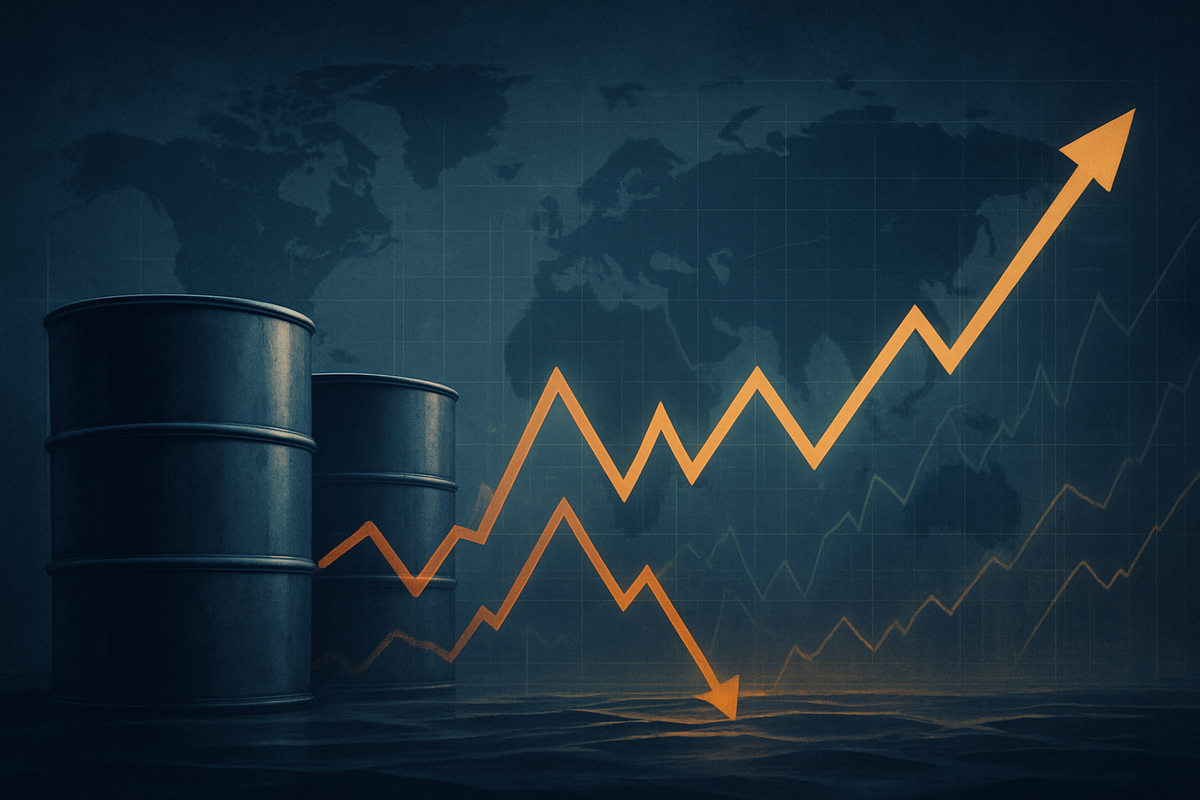
As November 2025 unfolds, global oil markets are experiencing a period of significant volatility, characterized by intermittent price rebounds that momentarily lift the energy sector, even as underlying concerns about oversupply and moderating demand persist. While recent geopolitical tensions have triggered short-lived surges in crude benchmarks, the broader outlook points towards a market grappling with robust production outpacing consumption growth, leading to a complex landscape for producers, consumers, and policymakers alike. This intricate dance between supply-side strength, demand-side uncertainty, and geopolitical flashpoints is shaping the trajectory of global inflation and influencing economic growth projections worldwide.
The immediate implications of these fluctuating prices are multifaceted. For the energy sector, brief upticks offer temporary boosts to profitability and incentivize continued, albeit cautious, investment in exploration and production. However, the overarching trend of moderating prices due to oversupply could pressure margins for some producers. For global inflation, the current environment of expected lower oil prices into 2026, despite occasional spikes, acts as a potential buffer, offering some reprieve for consumers at the pump and potentially easing pressure on central banks. Conversely, any sustained, significant increase could reignite inflationary concerns and impact monetary policy decisions. Economically, lower energy costs generally support consumer spending and industrial activity, but the very factors contributing to oversupply—such as concerns over global economic slowdown—also signal broader headwinds that could temper overall growth.
The Push and Pull of the Global Oil Market
The current state of the global oil market as of November 2025 is a testament to the powerful interplay of geopolitical events and fundamental supply-demand dynamics. While the year has seen moments where crude prices rallied, giving the impression of a robust rebound, these have largely been reactive spikes rather than a sustained upward trend. For instance, mid-November witnessed Brent crude briefly rising above $64 per barrel and West Texas Intermediate (WTI) around $60, following a two-week decline. A notable surge occurred on November 16 after reports of a Ukrainian drone attack on a Russian oil depot, highlighting how quickly geopolitical incidents can inject volatility into the market. Similarly, ongoing sanctions against Russian oil majors like Rosneft (MCX: ROSN) and Lukoil (MCX: LKOH), coupled with disruptions in Sudan and Iran's seizure of an oil tanker, provide an underlying tension that can prop up prices.
However, these episodic price increases are occurring within a broader context of impending oversupply. The International Energy Agency (IEA) has highlighted that global production is largely outpacing a more modest growth in demand, resulting in surging inventories worldwide. Non-OPEC+ and OPEC+ nations have been actively boosting supply, contributing significantly to this glut. In the United States, for example, eased regulations and reduced royalties have stimulated supply-side activity, particularly in shale and liquefied natural gas (LNG) exports. This robust supply picture has led analysts, including Goldman Sachs, to anticipate a significant surplus of approximately 2 million barrels per day through 2026, with forecasts for Brent to average $56 and WTI $52 in 2026, considerably lower than prices seen a year prior. Some even project Brent crude could dip into the $50-$60 range by early 2026, with a potential fall into the $40s if non-OPEC supply proves more resilient or a global recession materializes.
The refining sector also plays a critical role in this dynamic. Global refining capacity has faced constraints due to various factors, including the aforementioned Ukrainian attacks on Russian plants, outages in other regions, and permanent closures. These issues lead to squeezed refining margins and can keep prices for refined products, such as diesel, elevated, even if crude oil costs fluctuate. This disconnect means that consumers might not always see the full benefit of lower crude prices at the pump. The IEA's 2025 World Energy Outlook has also revised its projections, now forecasting that global oil and gas demand could continue to grow until 2050, a departure from earlier expectations of a peak this decade. This shift reflects a slowdown in the transition to cleaner fuels as some economies continue investing in fossil fuel projects, further complicating the long-term supply-demand balance.
Winners and Losers in a Volatile Oil Market
The fluctuating and generally moderating oil price environment creates a mixed bag of fortunes across various industries and companies. For oil and gas producers, particularly major integrated companies like ExxonMobil (NYSE: XOM), Chevron (NYSE: CVX), and Shell (LSE: SHEL), brief price upticks can temporarily boost their upstream profitability. However, the overarching trend of lower prices compared to a year ago, coupled with forecasts of continued oversupply, puts pressure on their revenue streams and investment decisions. Companies with lower production costs and stronger balance sheets are better positioned to weather these periods of moderation. Those heavily invested in shale plays, like Pioneer Natural Resources (NYSE: PXD) (before its acquisition by ExxonMobil) or EOG Resources (NYSE: EOG), might find their drilling economics challenged by sustained lower prices, although U.S. policy support for the sector could offer some cushioning.
Conversely, oilfield services companies such as Schlumberger (NYSE: SLB) and Halliburton (NYSE: HAL) might see a slowdown in new contract awards if producers become more cautious with their capital expenditures due to a bearish price outlook. However, the research indicates that the oil and gas mechanical and equipment industry is currently experiencing rising backlogs, suggesting that ongoing exploration and production activities are still providing some demand for their services, particularly for maintenance and optimization rather than purely new drilling.
The downstream sector, particularly refineries, faces its own set of challenges and opportunities. Companies like Valero Energy (NYSE: VLO) and Marathon Petroleum (NYSE: MPC) could benefit from strong refining margins if global refining capacity remains constrained due to outages or geopolitical events, even if crude input costs are stable or slightly lower. However, a significant drop in demand for refined products or a rapid increase in global refining capacity could erode these margins.
Airlines such as Southwest Airlines (NYSE: LUV) and Delta Air Lines (NYSE: DAL), and transportation and logistics companies like FedEx (NYSE: FDX) and UPS (NYSE: UPS), are generally beneficiaries of lower crude oil prices, as fuel is a significant operational cost. Reduced fuel expenses can lead to improved profitability, or allow them to offer more competitive pricing, potentially stimulating demand for their services. Similarly, consumers are significant winners, as lower crude prices typically translate to reduced gasoline and diesel prices at the pump, freeing up disposable income for other expenditures and easing household budgets.
However, renewable energy companies like NextEra Energy (NYSE: NEE) or Ørsted (CPH: ORSTED) might face indirect challenges. While the long-term transition to cleaner fuels remains a global imperative, a prolonged period of lower fossil fuel prices could potentially slow down the pace of this transition in some regions, making renewable projects appear less competitive in the short term, especially without robust policy support or carbon pricing mechanisms. Despite this, the IEA still expects renewable energies, particularly solar power, to experience the fastest growth among major energy sources.
Broader Implications and Industry Trajectories
The current state of the global oil market, marked by volatility and a prevailing outlook of oversupply, fits into a broader industry narrative defined by conflicting forces: the imperative of energy transition versus the persistent reliance on fossil fuels. This dynamic creates significant ripple effects across various sectors and regulatory landscapes. The IEA's revised outlook, suggesting continued growth in oil and gas demand until 2050, underscores a slower-than-anticipated shift away from traditional energy sources. This trend could mean sustained investment in fossil fuel infrastructure, potentially impacting the long-term viability and competitiveness of renewable energy projects if the cost differential widens.
The role of OPEC+ remains a critical determinant of market stability. Their decisions regarding production quotas directly influence global supply levels. In an environment of oversupply, any move by OPEC+ to maintain or increase production could further depress prices, while significant cuts could trigger price rallies. The group's ability to manage internal disagreements and adhere to production targets will be closely watched. Beyond OPEC+, the resilience of non-OPEC supply, particularly from the United States, has proven to be a major factor in the current glut. Technological advancements in shale extraction continue to enhance production efficiency, making U.S. producers more robust even at lower price points.
From a regulatory and policy standpoint, the current oil price environment has several implications. Governments in oil-producing nations face pressure to balance revenue generation with long-term energy transition goals. In the U.S., policies easing regulations and reducing royalties for the oil and gas sector are clearly aimed at stimulating supply, which has contributed to the current market conditions. Conversely, governments committed to climate targets might find it more challenging to push for aggressive renewable energy adoption if fossil fuel prices remain low and competitive. The ongoing geopolitical tensions, such as sanctions against Russia, also highlight how political decisions can directly impact global energy flows and prices, creating both disruptions and opportunities for alternative suppliers.
Historically, periods of oversupply have often led to significant price corrections and consolidation within the industry. The mid-2010s saw a similar glut, which forced many companies to cut costs, reduce capital expenditures, and streamline operations. While the current situation isn't as severe as that downturn, the cautionary tales from history suggest that companies must maintain financial discipline and operational efficiency to navigate prolonged periods of moderate or lower prices. The interplay between geopolitical risk premiums and fundamental oversupply makes this period particularly complex, as temporary price spikes can mask underlying market weaknesses.
Navigating the Future: What Comes Next
Looking ahead, the global oil market faces a complex array of short-term and long-term possibilities, demanding strategic pivots and adaptations from all stakeholders. In the short term, the market is likely to remain highly sensitive to geopolitical developments. Any escalation in conflicts in key oil-producing regions, further attacks on energy infrastructure, or significant shifts in sanctions policies could trigger immediate, albeit potentially temporary, price surges. Conversely, a de-escalation of tensions or a significant increase in supply from any major producer could quickly push prices downwards. Investors should closely monitor news from Eastern Europe, the Middle East, and any policy changes from major oil-producing nations. The ongoing tight refining capacity also suggests that refined product prices, such as diesel and jet fuel, might remain relatively elevated, impacting transportation costs even if crude prices moderate.
For the long term, the dominant theme will continue to be the tension between persistent fossil fuel demand and the accelerating energy transition. While the IEA's revised outlook suggests oil and gas demand might persist longer than previously thought, the underlying momentum towards renewables, particularly solar, is undeniable. This creates a challenging environment for traditional oil and gas companies, which must balance continued investment in fossil fuel production to meet current demand with strategic diversification into cleaner energy sources. Companies that successfully pivot towards integrated energy solutions, encompassing both traditional and renewable assets, may emerge as long-term winners. Conversely, those that fail to adapt risk becoming stranded assets in a decarbonizing world.
Potential strategic pivots for energy companies include increasing efficiency in existing operations, investing in carbon capture technologies, and expanding into hydrogen, biofuels, and offshore wind. For consumers, the long-term outlook might involve continued volatility at the pump, but potentially a gradual shift towards lower overall energy costs as renewable sources become more prevalent and efficient. Market opportunities may emerge in technologies that enhance energy efficiency, improve grid resilience, and facilitate the integration of diverse energy sources. Challenges include securing financing for large-scale renewable projects, overcoming infrastructure bottlenecks, and managing the social and economic impacts of transitioning away from fossil fuel-dependent industries.
Potential scenarios range from a "managed decline" where oil demand gradually tapers off alongside a robust build-out of renewables, to a "disrupted transition" marked by continued price volatility, geopolitical instability, and slower decarbonization progress. A "green acceleration" scenario, driven by aggressive policy action and rapid technological innovation, could see oil demand peak much sooner than anticipated. Investors should watch for shifts in government policy, technological breakthroughs in energy storage and efficiency, and the pace of investment in both traditional and renewable energy infrastructure. The next few months will be crucial in determining whether the market leans towards sustained oversupply and price moderation, or if unforeseen events will once again trigger significant upward pressure.
A Complex Horizon for Global Energy
The global oil market in November 2025 presents a nuanced and often contradictory picture. While the initial premise of a broad "rebound" in oil prices is not fully supported by the prevailing oversupply and moderating price outlook compared to a year ago, the market is undeniably characterized by significant volatility. Geopolitical tensions, such as drone attacks on Russian oil depots and ongoing sanctions, have repeatedly demonstrated their power to trigger brief, sharp price increases. These moments of uplift provide temporary relief and even profitability boosts for some segments of the energy sector, particularly producers and refiners benefiting from constrained capacity. However, the overarching narrative remains one of robust global production, especially from non-OPEC+ sources, outpacing a more modest growth in demand, leading to surging inventories and a generally bearish outlook for prices into 2026.
Moving forward, the market's trajectory will hinge on a delicate balance of factors. The actions of OPEC+ in managing supply, the resilience and growth of non-OPEC production (particularly U.S. shale), and the pace of global economic growth will be critical determinants. Any significant global economic slowdown could further dampen demand and exacerbate the oversupply, pushing prices lower. Conversely, unforeseen geopolitical events or unexpected supply disruptions could quickly reverse short-term trends. The energy transition, while a long-term imperative, is also playing a complex role; while renewables continue to grow, the IEA's revised outlook suggests that oil and gas demand might persist longer than previously thought, influencing investment decisions and market stability.
Investors should maintain a vigilant watch on several key indicators in the coming months. These include crude oil inventory levels (which reflect the supply-demand balance), OPEC+ production announcements, geopolitical developments in major oil-producing regions, and global economic growth forecasts. The performance of refining margins will also be telling, as they indicate the health of the downstream sector and can influence retail fuel prices. Finally, the ongoing policy debates surrounding energy transition and fossil fuel investment will shape the long-term landscape. The current environment underscores that the global energy market is in a dynamic state of flux, where short-term volatility and long-term structural shifts are constantly interacting, making for a challenging yet fascinating period for all involved.
This content is intended for informational purposes only and is not financial advice





